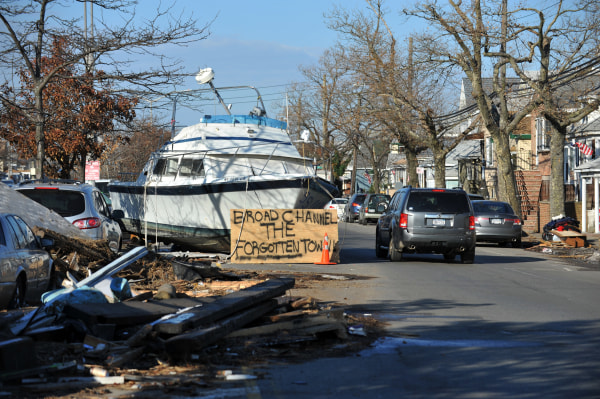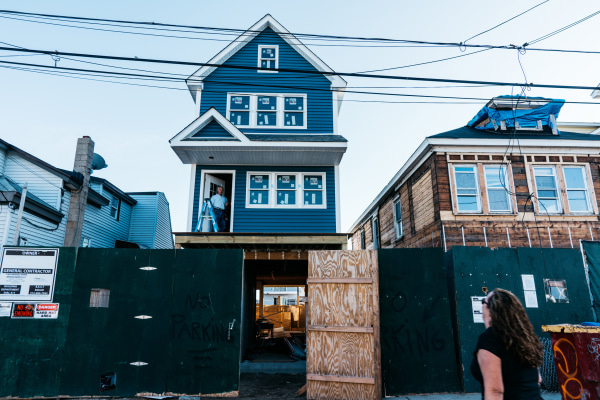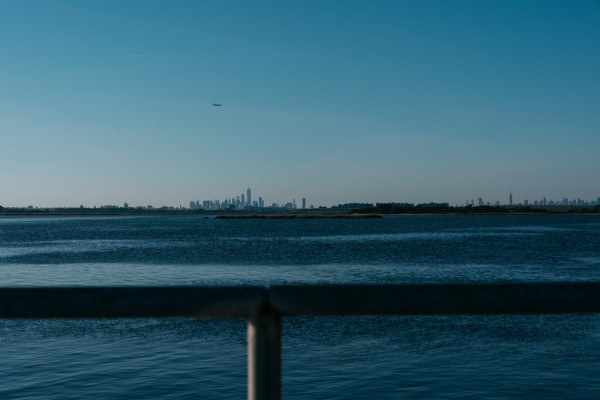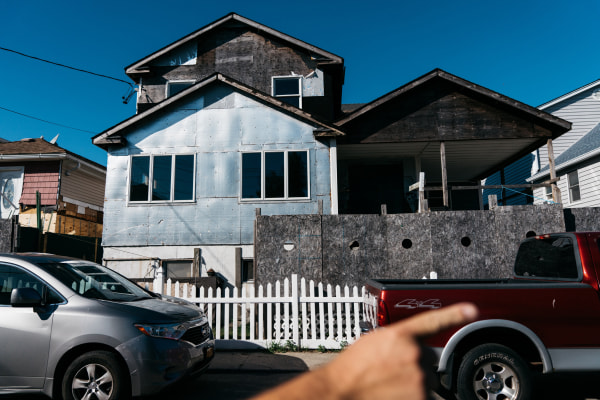This story has been jointly published by NBCNews.com and The Weather Channel.
The frenzy of construction might suggest a housing boom rippling across Broad Channel, a neighborhood in Queens, New York, popular with municipal workers, police officers and firefighters.
But five years after Superstorm Sandy submerged this sleepy, mile-long strip of island in 6 feet of seawater, Broad Channel is stuck in a redevelopment limbo symbolized by a curious sight: homes being raised on Jenga-blocklike stilts.
The work is part of a larger effort to buttress the city's most vulnerable neighborhoods.
But a crucial question remains: Is the groundwork being laid enough to protect America's most populous city from future floods, extreme weather and rising sea levels?
"The real dynamic that we've learned here with Sandy is that climate change isn't something that happens far away to someone else," said Daniel Zarrilli, senior director for climate policy and chief resilience officer for Mayor Bill de Blasio. "It's here, and it's now."
Sandy battered New York on Oct. 29, 2012, killing 43 people, cutting power to almost 2 million residents and causing $19 billion in property and economic damage.

On Broad Channel, John and Alison Kase packed up their car and took their young sons, Jake and Logan, and fled from the bungalow-like home that had been passed down through John's family. A neighbor who decided not to evacuate filmed the water from Jamaica Bay as it surged like a river onto their street.
"My little house looked like a little bar of soap inside of a huge washing machine," said Alison Kase, 44. "It was devastating to see how the water came just underneath my windows. … It was quite out of body."
Two feet of water spilled inside. Seaweed from the bay seeped into their stove. Furniture and pictures were lost.
While the house itself was salvageable, the reconstruction was pegged at $50,000 to $75,000 — an overwhelming amount for Alison, a blogger, and John, a sanitation worker. Any immediate repairs were mired in red tape over their flood insurance, they said.
They sought help from the city's Rapid Repairs program to patch up their boiler, before trying to join Build It Back, another rebuilding program that later became the subject of complaints, including for being over budget and riddled with delays.
More than 8,300 owners of Sandy-damaged homes have had construction started or will get help through Build It Back — although that's less than half of the original 20,275 applicants who signed up, according to an analysis by the City Comptroller's Office that was first reported by The New York Daily News last month.
While the Kases considered propping up their home by several feet under Build It Back, they were dismayed by the idea of having to vacate for an unknown period of time during the reconstruction, and they didn't think the house could be elevated safely.
So they turned to family and friends in Broad Channel, as well as religious groups and charities, including Friends of Rockaway and Family-to-Family, to rehab and replace. It wasn't until a year and a half after the storm hit that everything was completed.
"We refer to our house as the Iron Lady, and we had to keep servicing the Iron Lady," Alison Kase said. But if another large storm were to hit Broad Channel, "I don't know that we would necessarily stay," she said.

But as past storms have shown, plenty of people are willing to take the risk. And if Sandy taught city officials anything, it's that they have an array of options at their disposal.
In Broad Channel and the larger area known as the Rockaways, a neighboring peninsula that juts out into Jamaica Bay, the city has projects underway at various stages, including raising streets, repairing bulkheads, restoring marshes and building a $58 million dune system in Breezy Point. That community was devastated during the flooding when an electrical line sparked a fire, incinerating more than 135 homes and leaving behind an apocalyptic-looking landscape.
Another one of the city's signature projects has been the rebuilding this year of the wooden boardwalk in Rockaway Beach. The upgraded esplanade was made of concrete, included retaining walls and dunes, and was designed with future hurricanes in mind.
Elsewhere in the city, similar bulkhead and barrier projects are proposed, including in Coney Island and Sea Gate in Brooklyn. Hundreds of millions of dollars worth of coastal resiliency projects are also scheduled for lower Manhattan, which saw subway stations shuttered for months in some of the city's worst flooding from Sandy, and on the East Side, where dunes were significantly eroded.

Action is imperative, officials say, because an estimated 400,000 New Yorkers live within the city's floodplain, which includes heavily populated neighborhoods that make up the 520 miles of coastline.
A study released Monday and completed by researchers at several universities, including Rutgers, the Massachusetts Institute of Technology and Princeton, found that the chance of a major storm directly striking New York is less likely because of the effects of climate change. However, the flooding that could occur would be much more intense, and by 2030, floods of 7 feet or more could occur as often as every five years.
The study didn't suggest what public officials could do. But Zarrilli said he's certain that "New York is safer than it was when Sandy hit."
Radley Horton, a climate scientist and adviser for the global warming-related docuseries "Years of Living Dangerously," added that New York is "definitely moving in the right direction."
"If any city has the financial resources to bring to bear much of what's on its list, it's New York," said Horton, also a Lamont associate research professor at Columbia University.
But while a city can dream up a host of projects, finding the funding for these costly endeavors is another issue.
It's even more complicated on the federal level, with the Trump administration proposing to cut money for climate-related scientific research and grants as part of the fiscal year 2018 budget. (The billions of dollars in aid relief for New York and New Jersey were already allocated by Congress three months after Sandy struck.)
After President Donald Trump in June announced plans to pull the United States out of the Paris climate accord, meant to curb greenhouse gas emissions, Zarrilli said it was important that mayors of big cities didn't allow Washington to derail their efforts.
New York and other coastal cities, including New Orleans, Miami Beach and Los Angeles, have vowed to combat climate change and invest in renewable energy.
Climate change, Zarrilli added, isn't just about warding off rising waters or coping with more fearsome hurricanes, but also preparing for the increase in hotter weather. New York has been repainting roofs a "cooler" white and planted additional trees as canopies in urban neighborhoods in the South Bronx and upper Manhattan.
"There isn't any one big thing we can do," Zarrilli said. "We are going to be addressing the risk of climate change" for generations.
But there is one drastic alternative the city has employed: encouraging people to move out of certain streets or even whole neighborhoods in flood-prone areas. That prospect becomes trickier when considering New York's diverse demographics, spanning working-class communities in Brooklyn and Queens to owners of multimillion-dollar residences in Manhattan.
"One of the grand challenges of the 21st century will be to devise strategies, and we face a huge experiment: Can we develop techniques to remove people from high-risk areas in a way that doesn't leave the most vulnerable exposed or left behind?" Horton asked.

Such a wind down was completed on Staten Island, where more than 300 homeowners in the Oakwood Beach neighborhood were voluntarily bought out by the state for a total of $123 million. That was part of a continuing effort after Sandy to return sections of the borough that consistently flood back to nature.
But buyout programs can also be met with opposition and raise questions about the property rights of individuals.
"These are very controversial," said Timothy Hall, a senior scientist with NASA's Goddard Institute for Space Studies. "People don't like to be told this, but those are the kinds of policies that would make the most sense to me. ... You can look at giant flood walls, but they tend to be fantastically expensive, they can protect some areas, but not all areas."
Joseph Lynch, 69, can't fathom having to leave his home in south Brooklyn's Gerritsen Beach, which was almost entirely inundated by tidal surge waters during Sandy. If another catastrophic storm were to strike, however, he would consider forsaking the home that his grandmother bought in the 1930s, he said.
"I was starting to feel a little hopeless after Sandy," said Lynch, whose one-story home was decimated by 4 feet of water. With little time to get out, he said, he lost his cameras, bicycles and other keepsakes, and was barely able to rescue his cat, Jump.
"If this is going to happen again, where am I going to go? I can't stay here anymore," he said.
But he may find a solution similar to what's happening in Broad Channel: His home has been selected as the first to benefit from Project Uplift, a $9.3 million state program to elevate dwellings of low- and moderate-income homeowners.
SBP, a nonprofit disaster recovery group that runs Friends of Rockaway, is administering the pilot phase that will help 28 homes in Brooklyn and Staten Island.
Alana Tornello, the project's program administrator, said raising homes is an essential way to protect people's livelihoods for the foreseeable future.
"It's so insensitive to think of asking 400,000 people, some of whom have helped to build New York City, to leave," Tornello said. "I think it's our commitment as New Yorkers to each other to do all that we can to protect communities that are essential to this city."
With construction set to start on his home, Lynch found temporary housing at the local Roman Catholic church where he is also a custodian. By next spring, program officials say, his house will be higher — and safer.
"You think, Sandy is a one-in-a-century event, and by the time I go, it's probably not going to happen again in my lifetime," Lynch said. "But what about other people? I can't just think about me. We all have to think about the future."
No comments:
Post a Comment